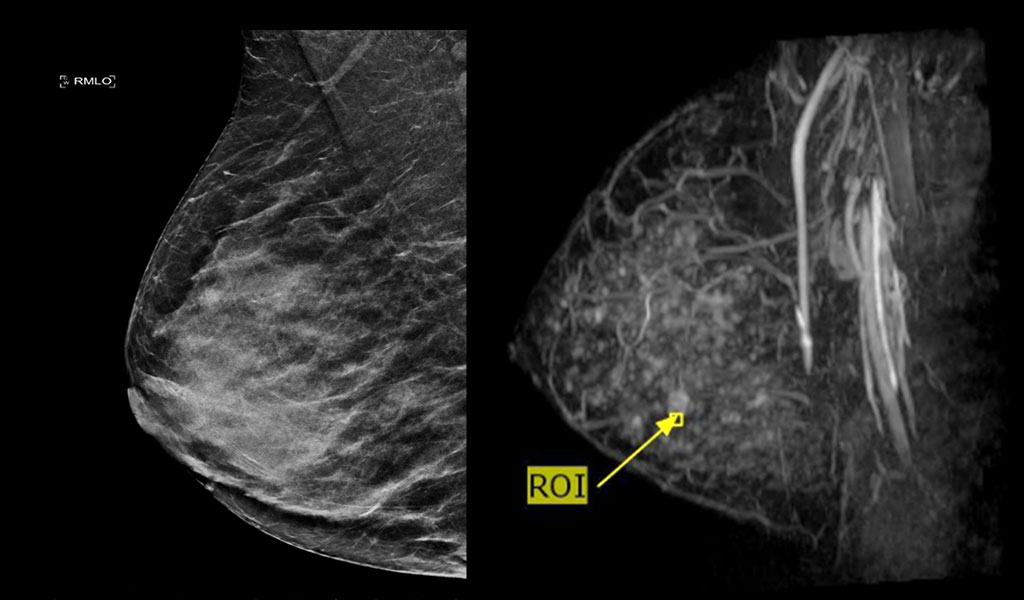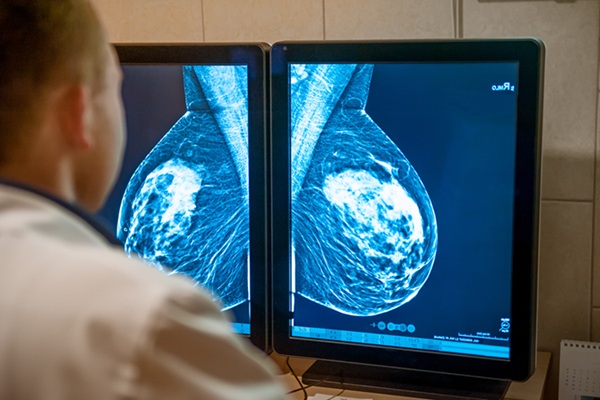Majority of Women Prefer Abbreviated Breast MRI Screening
|
By MedImaging International staff writers Posted on 24 Nov 2021 |

Image: AB-MRI (R) reveals a 10mm mass, not seen on mammogram (L) due to marked breast density (Photo courtesy of St. Vincent`s Private Hospital)
A new study reveals that abbreviated Breast MRI (AB-MRI) is well tolerated, with 75% of surveyed patients selecting it as their preferred modality for screening.
The survey, conducted among 200 asymptomatic patients at average to mildly elevated risk of breast cancer at St. Vincent's Private Hospital (Sydney, Australia), included 199 women and one man (mean age 53 years), of whom 86% were classified as BIRADS 1 and 2, and 14% being BIRADS 3-5. All exams were performed on a 3-tesla MRI scanner using dedicated breast coils with patients in the prone position; 7.5 ml of intravenous gadobutrol was administered during the exam. In all, 155 patients were recommended to return to routine screening, and 28 patients (identified as BIRADS ≥ three) were recommended for further investigations.
AB-MRI screened identified nine breast cancers in eight patients, for a cancer detection rate of 4.5%, and a positive predictive value (PPV) 44% higher than screening mammography; cancer detection was not limited by breast density. Overall, 63% of patients preferred AB-MRI screening, while 21% preferred mammography; 16% said they were unable to compare the two techniques. IV contrast administration was rated as an excellent/good experience by 68%. The study was presented at the virtual Royal Australian & New Zealand College of Radiology (RANZCR) annual scientific meeting.
“AB-MR was well tolerated by patients, with 75% of surveyed patients selecting it as their preferred modality for screening,” concluded senior author Linda Borella, MD, and colleagues. “The results of this study may be used to inform further research to assess the cost-effectiveness of abbreviated breast MRI for wider population-based screening and to support the incorporation of abbreviated breast MRI into Australian breast cancer screening guidelines.”
Breast MRI has the highest cancer detection rate of all breast imaging exams across all breast density categories. Traditionally, breast MRI has been reserved for high-risk women due to the cost, length of exam, and availability of interpretation time. AB-MRI is a shortened version of breast MRI that is designed to detect biologically aggressive invasive cancers and high-grade ductal carcinoma in situ (DCIS) at early stages. The sensitivity of AB-MRI is comparable to that of conventional MRI.
Related Links:
St. Vincent's Private Hospital
The survey, conducted among 200 asymptomatic patients at average to mildly elevated risk of breast cancer at St. Vincent's Private Hospital (Sydney, Australia), included 199 women and one man (mean age 53 years), of whom 86% were classified as BIRADS 1 and 2, and 14% being BIRADS 3-5. All exams were performed on a 3-tesla MRI scanner using dedicated breast coils with patients in the prone position; 7.5 ml of intravenous gadobutrol was administered during the exam. In all, 155 patients were recommended to return to routine screening, and 28 patients (identified as BIRADS ≥ three) were recommended for further investigations.
AB-MRI screened identified nine breast cancers in eight patients, for a cancer detection rate of 4.5%, and a positive predictive value (PPV) 44% higher than screening mammography; cancer detection was not limited by breast density. Overall, 63% of patients preferred AB-MRI screening, while 21% preferred mammography; 16% said they were unable to compare the two techniques. IV contrast administration was rated as an excellent/good experience by 68%. The study was presented at the virtual Royal Australian & New Zealand College of Radiology (RANZCR) annual scientific meeting.
“AB-MR was well tolerated by patients, with 75% of surveyed patients selecting it as their preferred modality for screening,” concluded senior author Linda Borella, MD, and colleagues. “The results of this study may be used to inform further research to assess the cost-effectiveness of abbreviated breast MRI for wider population-based screening and to support the incorporation of abbreviated breast MRI into Australian breast cancer screening guidelines.”
Breast MRI has the highest cancer detection rate of all breast imaging exams across all breast density categories. Traditionally, breast MRI has been reserved for high-risk women due to the cost, length of exam, and availability of interpretation time. AB-MRI is a shortened version of breast MRI that is designed to detect biologically aggressive invasive cancers and high-grade ductal carcinoma in situ (DCIS) at early stages. The sensitivity of AB-MRI is comparable to that of conventional MRI.
Related Links:
St. Vincent's Private Hospital
Latest MRI News
- AI-Assisted Model Enhances MRI Heart Scans
- AI Model Outperforms Doctors at Identifying Patients Most At-Risk of Cardiac Arrest
- New MRI Technique Reveals Hidden Heart Issues
- Shorter MRI Exam Effectively Detects Cancer in Dense Breasts
- MRI to Replace Painful Spinal Tap for Faster MS Diagnosis
- MRI Scans Can Identify Cardiovascular Disease Ten Years in Advance
- Simple Brain Scan Diagnoses Parkinson's Disease Years Before It Becomes Untreatable
- Cutting-Edge MRI Technology to Revolutionize Diagnosis of Common Heart Problem
- New MRI Technique Reveals True Heart Age to Prevent Attacks and Strokes
- AI Tool Predicts Relapse of Pediatric Brain Cancer from Brain MRI Scans
- AI Tool Tracks Effectiveness of Multiple Sclerosis Treatments Using Brain MRI Scans
- Ultra-Powerful MRI Scans Enable Life-Changing Surgery in Treatment-Resistant Epileptic Patients
- AI-Powered MRI Technology Improves Parkinson’s Diagnoses
- Biparametric MRI Combined with AI Enhances Detection of Clinically Significant Prostate Cancer
- First-Of-Its-Kind AI-Driven Brain Imaging Platform to Better Guide Stroke Treatment Options
- New Model Improves Comparison of MRIs Taken at Different Institutions
Channels
Radiography
view channel
AI Algorithm Uses Mammograms to Accurately Predict Cardiovascular Risk in Women
Cardiovascular disease remains the leading cause of death in women worldwide, responsible for about nine million deaths annually. Despite this burden, symptoms and risk factors are often under-recognized... Read more
AI Hybrid Strategy Improves Mammogram Interpretation
Breast cancer screening programs rely heavily on radiologists interpreting mammograms, a process that is time-intensive and subject to errors. While artificial intelligence (AI) models have shown strong... Read moreUltrasound
view channel
Disposable Ultrasound Patch Performs Better Than Existing Devices
Wearable ultrasound devices are widely used in diagnostics, rehabilitation monitoring, and telemedicine, yet most existing models rely on lead-based piezoelectric ceramics that pose health and environmental risks.... Read more
Non-Invasive Ultrasound-Based Tool Accurately Detects Infant Meningitis
Meningitis, an inflammation of the membranes surrounding the brain and spinal cord, can be fatal in infants if not diagnosed and treated early. Even when treated, it may leave lasting damage, such as cognitive... Read moreNuclear Medicine
view channel
PET Tracer Enables Same-Day Imaging of Triple-Negative Breast and Urothelial Cancers
Triple-negative breast cancer (TNBC) and urothelial bladder carcinoma (UBC) are aggressive cancers often diagnosed at advanced stages, leaving limited time for effective treatment decisions.... Read more
New Camera Sees Inside Human Body for Enhanced Scanning and Diagnosis
Nuclear medicine scans like single-photon emission computed tomography (SPECT) allow doctors to observe heart function, track blood flow, and detect hidden diseases. However, current detectors are either... Read more
Novel Bacteria-Specific PET Imaging Approach Detects Hard-To-Diagnose Lung Infections
Mycobacteroides abscessus is a rapidly growing mycobacteria that primarily affects immunocompromised patients and those with underlying lung diseases, such as cystic fibrosis or chronic obstructive pulmonary... Read moreGeneral/Advanced Imaging
view channel
New Ultrasmall, Light-Sensitive Nanoparticles Could Serve as Contrast Agents
Medical imaging technologies face ongoing challenges in capturing accurate, detailed views of internal processes, especially in conditions like cancer, where tracking disease development and treatment... Read more
AI Algorithm Accurately Predicts Pancreatic Cancer Metastasis Using Routine CT Images
In pancreatic cancer, detecting whether the disease has spread to other organs is critical for determining whether surgery is appropriate. If metastasis is present, surgery is not recommended, yet current... Read moreImaging IT
view channel
New Google Cloud Medical Imaging Suite Makes Imaging Healthcare Data More Accessible
Medical imaging is a critical tool used to diagnose patients, and there are billions of medical images scanned globally each year. Imaging data accounts for about 90% of all healthcare data1 and, until... Read more
Global AI in Medical Diagnostics Market to Be Driven by Demand for Image Recognition in Radiology
The global artificial intelligence (AI) in medical diagnostics market is expanding with early disease detection being one of its key applications and image recognition becoming a compelling consumer proposition... Read moreIndustry News
view channel
GE HealthCare and NVIDIA Collaboration to Reimagine Diagnostic Imaging
GE HealthCare (Chicago, IL, USA) has entered into a collaboration with NVIDIA (Santa Clara, CA, USA), expanding the existing relationship between the two companies to focus on pioneering innovation in... Read more
Patient-Specific 3D-Printed Phantoms Transform CT Imaging
New research has highlighted how anatomically precise, patient-specific 3D-printed phantoms are proving to be scalable, cost-effective, and efficient tools in the development of new CT scan algorithms... Read more
Siemens and Sectra Collaborate on Enhancing Radiology Workflows
Siemens Healthineers (Forchheim, Germany) and Sectra (Linköping, Sweden) have entered into a collaboration aimed at enhancing radiologists' diagnostic capabilities and, in turn, improving patient care... Read more




















